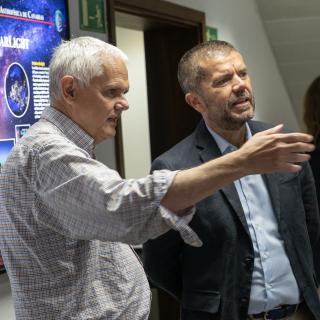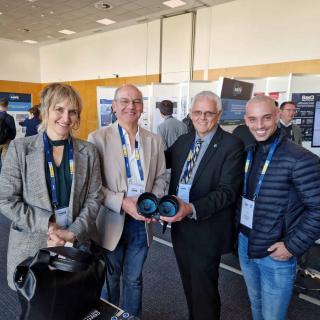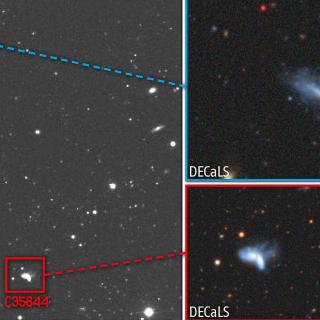As happens every year, the Perseids, also known in Spain as “St. Lawrence’s Tears” will reach their peak of activity in mid-August. In 2017 the Perseids’ activity will take place between 17th July and 24th August. The maximum is expected between 14:00 UT (Universal Time, an hour more in the Canary Islands and two more in the Peninsula) on August 12th and 2:30 UT on August 13th. So in Europe the night of 12th to 13th August will be the best time to observe this meteor shower. The waning moon, at 70% of full moon, will appear during the second half of the night and will not make it easy to observe the meteors. On average an observer should be able to see one meteor every five minutes, some of them very bright, due to their high velocities when entering the atmosphere.
To see these bright meteors, it is important to be in a dark place, free from light pollution, and with a clear view of the horizon. According to Miquel Serra-Ricart, and astronomer at the IAC “even with the bright moon in the sky the intensity of the Perseids should assure that they can be observed, with an activity around the maximum which stays high, and fairly constant, between 70 and 130 meteors per hour during the past ten years. This year we won’t see the fainter Perseids, but the brighter ones should present an attractive spectacle”.
A historical shower
So called “shooting stars” are really dust particles of different sizes, some smaller than grains of sand, which are left behind by comets or asteroids as they travel along their orbits around the sun. The resulting cloud of particles (meteoroids) which form as a result of the heating of the cometary remnants as they pass by the sun, is dispersed along the orbit of the comet, and the Earth on its orbit around the Sun crosses this cometary orbit every year. During this encounter, the dust particles disintegrate as they enter the Earth’s atmosphere at high velocity, giving rise to the luminous streaks in the sky which have the scientific name of meteors.
The Perseids’ activity is in the range of 100 meteors per hour (ZHR, or zenith counts per hour) based on calculations with standard models, and their origin is the comet Swift-Tuttle, discovered in 1862. In the years close to the perihelion passage of Swift-Tuttle, the years when it makes its closest approach to the Sun, the activity can reach 400-500 meteors per hour, due to the high density of meteoroids which surround and accompany the comet. The last perihelion passage of Swift-Tuttle was in 1992, and the next will be in 2126.
The Perseids are known for their “bursts of activity” caused by the gravitational influence of the major planets, Jupiter and Saturn, on the clouds of dust shed by a comet in the past. In 1839 the German observer Eduard Heis made the first count of the maximum rate of the Perseids. 160 meteors/hour. Until 1858 this varied between 37 and 88 meteors/hour. In 1920 the Perseids reached 200 meteors/hour and 187 in 1983. In 2016 the predictions of the Russian astronomer Mikhail Maslov were fulfilled, and the Perseid activity reached 200 meteors per hour (ZHR) due to the “Jupiter effect”. The predictions for 2017 are more modest, although Maslov mention a Perseid activity higher than normal.
Meteor shower live
The portal sky-live.tv, in collaboration with the European project STARS4ALL will make a direct transmission of the meteor shower from the Teide Observatory (Tenerife) and the Astronomical Park of Montsèc (Lleida). The total time of the transmission will be 60 minutes, with the following timetable:
Connection 12th August 22:00-23:00 UT
(13th August 0:00-1:00 CEST, 12th August 23:00-24:00 in the Canaries)
Three Spanish supercomputing centres, the Centro Extremeño de Tecnologías Avanzadas (CETA-CIEMAT), the Consorci de Serveis Universitaris de Catalunya (CSUC) and the Instituto de Astrofísica de Canarias (IAC) will collaborate in the distribution of the signal from the web portal (sky-live.tv).
STARS4ALL (stars4all.eu) is a project funded by the H2020 Programme of the European Union, under contract number 688135. 8 institutions from 6 European countries are working within STARS4ALL (UPM, CEFRIEL, SOTON, ECN, ESCP Europe, IAC, IGB and UCM). The aim of STARS4ALL is to make the general public aware of the existence of light pollution in many of the places where we live, and of the importance of taking measures to reduce it.
Citizen Science and Educational Activities
1. Calulating the Perseids activity.
The SOMYCE (Society of Observers of Meteors and Comets of Spain) has made an interesting proposal: to calculate the Perseids activity using visual observations.
It will also be possible to take part in the calculation of the activity of the Shower by sending data to the International Meteor Organization (IMO, information).
2. Calculating the height of formation of meteors
At the Canary Island Observatories of the IAC the project AMOS.Cl will carry out observations of the Perseids simultaneously from Tenerife (Teide Observatory) and La Palma (Roque de Los Muchachos Observatory), which are 150 km apart. With these data it will be possible, using parallax, to calculate the height of formation of the meteor trails, and their orbits.
We encourage students to use the same technique and to apply it to observations of last year’s Perseids and the Geminids. Details can be found at the Didactic Activity website “Calculation of meteor formation” of astroaula.net.
More information
Meteor showers 2017
http://www.imo.net/files/meteor-shower/cal2017.pdf
http://www.imo.net/calendar/2016
Audiovisual material
Video of the Perseids 2017: https://www.dropbox.com/s/z9kbujda9g006kj/perseidas110817-dpadron.mp4?dl=0
Video of the Perseids 2016: https://youtu.be/gJyGY7RistI
Images and sequences of the Perseids 2016: https://flic.kr/s/aHskGCUkqd
High resolution images of Meteor Showers: https://flic.kr/s/aHsjH2BFa4
Channels for transmission
Youtube
Astronomical Park of Montsèc: https://youtu.be/-Y1nfBn_UGE
Teide Observatory: https://youtu.be/XP9892oCZLU



